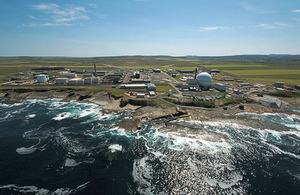Dounreay announces destruction of major hazard
Dounreay today completed the destruction of one of the most hazardous legacies of Britain’s earliest atomic research.

Dounreay announces destruction of major hazard
A purpose-built chemical plant processed the last of 57,000 litres of liquid metal lifted from the primary cooling circuit of the experimental fast breeder reactor.
The coolant – an alloy of sodium and potassium (NaK) – was a major chemical and radiological hazard. An estimated 1000 trillion becquerels of caesium-137 was removed from the coolant during the chemical process that turned the 57 tonnes of liquid metal into 20,000 tonnes of salty water and took four years to complete.
Scotland’s Cabinet Secretary for the Environment Richard Lochhead saw the last batches being processed said:
This is a tremendous achievement and another example of how the highly skilled Dounreay workforce is delivering a world-class clean-up operation at one of the most complex nuclear sites in Europe.
The Scottish Government welcomes today’s announcement that Dounreay have successfully destroyed 57,000 litres of highly radioactive liquid metal from the Dounreay Fast Reactor.
Nigel Lowe, head of the NDA’s Dounreay programme, said:
This was very high on the list of hazards we wanted reduced across our whole estate,” said . “It’s a significant achievement for Dounreay and joins a long list of examples whereby the site has delivered on key objectives and technical challenges.
The reactor – built in the 1950s – was one of only two ever built in Britain to run on liquid metal. Two cooling circuits connected by heat exchangers were filled with more than 161,000 litres of liquid metal.
More than 100,000 litres of NaK from the secondary circuit was destroyed when the reactor shut down in 1977. Work on the primary circuit – a labyrinth of pipes 9 kilometres in length – stopped in the early 1980s when higher levels of radioactive contamination were detected.
The primary circuit contained 57,000 litres of NaK that flowed over the fuel pins in the reactor core. The “open vent” design of the fuel cladding allowed the liquid metal to come into direct contact with the fuel, contaminating the primary coolant with huge levels of soluble radioactive caesium. Radiation measurements of the primary coolant showed the presence of 1000 trillion becquerels of caesium-137.
The high level of radioactive contamination added to the chemical hazard of alkali metal that reacts in contact with air or water.
Its destruction remained on hold until a decade ago when work started on the construction of a purpose-built clean-up plant.
The plant was designed to lift the liquid metal in small batches, neutralise the alkalinity with acid and extract the caesium via ion exchange.
In September 2007, the first of a total of 354 batches was lifted from the reactor. Each batch underwent chemical neutralisation to convert the alkali metal to a salty water before being passed through ion exchange columns that trapped the caesium.
Designers thought the plant would decontaminate the effluent by a factor of 1000. Decontamination rates of up to 4 million were achieved during the operation, reducing levels of radioactivity in the effluent to below the limit of detection. The resin columns used to trap the caesium will now be cemented up and managed as higher-activity waste.
Andy Swan, the engineer in charge of the reactor decommissioning, said:
It’s been a fantastic achievement by the whole team to deliver this milestone a year ahead of schedule and to higher environmental standards than anyone thought possible at the design stage.
This stuff was highly volatile and highly radioactive. The chemical and radiological hazards combined to make this a real danger to the workers involved, so we needed to be certain they were protected at every step of the process until the hazard was destroyed. Their safety record throughout this operation was excellent.
With the reactor vessel empty of liquid metal, attention now turns to cleansing the residual traces from the primary circuit pipework and destroying small pockets in other vessels. When complete, a robotic arm will reach into the reactor vessel and begin removing the burst fuel pin and almost 1000 breeder elements still positioned around the core.